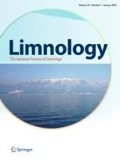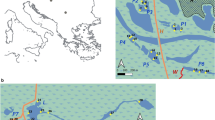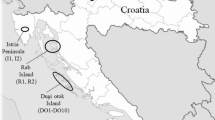Abstract
Nutrient-rich water bodies are usually expected to host low species richness at the local scale (water body). Nevertheless, they can support a diverse and sometimes unique biodiversity when diversity is considered at a regional scale. This discrepancy between the two scales is well documented for natural water bodies, but little is known about biodiversity of artificial water bodies, like fish ponds. We hypothesise that nutrient-rich water bodies can collectively host high species richness at the regional scale. Thus, these are important ecosystems for the regional conservation of biodiversity. We investigated 84 fish ponds in the Dombes region, France, with five taxonomic groups: macrophytes, phytoplankton, macroinvertebrates, dragonflies, and amphibians. Species richness patterns were determined for α- (single pond), β- (between ponds), and γ- (regional pond network) levels. For most studied species groups, richness per fish pond and at the regional level proved to be relatively high in comparison with natural ponds in other landscapes. Contribution of α-diversity to regional diversity was highest for dragonflies with 41 %, and lowest for amphibians and macrophytes with 16 and 18 %, respectively. For macroinvertebrate families and phytoplankton genera it was intermediate. Contribution of β-diversity to regional diversity was similar for all species groups with 22–25 %. Furthermore, some ponds hosted a large number of less frequent species and some endangered species, indicating that the conservation of biodiversity of fish ponds must be established at a regional scale.




Similar content being viewed by others
References
Akasaka M, Takamura N (2012) Hydrologic connection between ponds positively affects macrophyte α and γ diversity but negatively affects β diversity. Ecology 93:967–973
Arthaud F, Mousset M, Vallod D, Robin J, Wezel A, Bornette G (2012a) Effect of light stress from phytoplankton on the relationship between aquatic vegetation and the propagule bank in shallow lakes. Freshw Biol 57:666–675
Arthaud F, Vallod D, Robin J, Bornette G (2012b) Eutrophication and drought disturbance shape functional diversity and life-history traits of aquatic plants in shallow lakes. Aquat Sci 74(3):471–481
Arthaud F, Vallod D, Wezel A, Robin J, Bornette G (2013) Short-term succession of aquatic plant species richness along ecosystem productivity and dispersal gradients in shallow lakes. J Veg Sci 24(1):148–156
Biggs J, Williams P, Whitfield M, Nicolet P, Weatherby A (2005) 15 years of pond assessment in Britain: result and lessons learned from the work of pond conservation. Aquat Conserv 15:693–714
Bouvy M, Ba N, Ka S, Sane S, Pagano M, Arfi R (2006) Phytoplankton community structure and species assemblage succession in a shallow tropical lake (Lake Guiers, Senegal). Aquat Microb Ecol 45:147–161
Brönmark C, Hansson LA (2002) Environmental issues in lakes and ponds: current state and perspectives. Environ Conserv 29:290–307
Broyer J, Calenge C (2010) Influence of fish-farming management on duck breeding in French fish pond systems. Hydrobiologia 637:173–185
Broyer J, Curtet L (2012) Biodiversity and fish farming intensification in French fishpond systems. Hydrobiologia 694:205–218
Carson WP, Barett GW (1988) Succession in old-field communities: effects of contrasting types of nutrient enrichment. Ecology 69:984–994
Chambers PA, Kalff J (1987) Light and nutrients in the control of aquatic plant community structure. I. In situ experiments. J Ecol 75:611–619
Chase JM, Leibold MA (2002) Spatial scale dictates the productivity-biodiversity relationship. Nature 416:427–430
Chovanec A, Waringer J (2001) Ecological integrity of river-floodplain systems-assessment by dragonfly surveys (Insecta: Odonata). Regul Rivers Res Manag 17:493–507
Colwell RK (2009) EstimateS: statistical estimation of species richness and shared species samples. http://priede.bf.lu.lv/ftp/pub/GIS/datu_analiize/EstimateS/EstimateSUsersGuide.htm. Accessed Nov 2012
Davies B, Biggs J, Williams P, Whitfield M, Nicolet P, Sear D, Bray S, Maund S (2008) Comparative biodiversity of aquatic habitats in the European agricultural landscape. Agric Ecosyst Environ 125(1–4):1–8
Dodson SI, Arnott SE, Cottingham KL (2000) The relationship in lake communities between primary productivity and species richness. Ecology 81:2662–2679
Edvarsen A, Okland RH (2006) Variation in plant species richness in and adjacent to 64 ponds in SE Norwegian agricultural landscapes. Aquat Bot 85:79–91
Gómez-Rodríguez C, Díaz-Paniagua C, Bustamante J, Portheault A, Florencio M (2010) Inter-annual variability in amphibian assemblages: implications for diversity assessment and conservation. Aquat Conserv Mar Freshw Ecosyst 20:668–677
Grover JP, Chrzanowski TH (2005) Seasonal dynamics of phytoplankton in two warm temperate reservoirs. J Plankton Res 27:1–17
Hambright KD, Zohary T (2000) Phytoplankton species diversity control through competitive exclusion and physical disturbances. Limnol Oceanogr 45:110–122
Huston MA (1994) Biological diversity: the coexistence of species on changing landscapes. Cambridge University Press, England
Indermuehle N, Angélibert S, Rosset V, Oertli B (2010) The pond biodiversity index “IBEM”: a new tool for the rapid assessment of biodiversity in ponds from Switzerland. Part 2. Method description and examples of application. Limnetica 29:105–120
Interlandi SJ, Kilham SS (2001) Limiting resources and the regulation of diversity in phytoplankton communities. Ecology 82(5):1270–1282
Jeppesen E, Lauridsen TL, Mitchell SF, Christoffersen K, Burns CW (2000) Trophic structure in the pelagial of 25 shallow New Zealand lakes: changes along nutrient and fish gradients. J Plankton Res 22:951–968
Jost L (2007) Partitioning diversity into independent alpha and beta components. Ecology 88:2427–2439
Kloskowski J (2010) Fish farms as amphibian habitats: factors affecting amphibian species richness and community structure at carp ponds in Poland. Environ Conserv 37(2):187–194
Kloskowski J (2011) Differential effects of age-structured common carp (Cyprinus carpio) stocks on pond invertebrate communities: implications for recreational and wildlife use of farm ponds. Aquac Int 19(6):1151–1164
Knutson MG, Richardson WB, Reineke DM, Gray BR, Parmelee JR, Weick SW (2004) Agricultural ponds support amphibian populations. Ecol Appl 14(3):669–684
Koleff P, Gaston KJ, Lennon JK (2003) Measuring beta diversity for presence-absence data. J Anim Ecol 72:367–382
Kunii H (1991) Aquatic macrophyte composition in relation to environmental factors of irrigation ponds around Lake Shinji, Shimane, Japan. Vegetatio 97:137–148
Lande R (1996) Statistics and partitioning of species diversity, and similarity among multiple communities. Oikos 76:5–13
Le Roux X, Barbault R, Baudry J, Burel F, Doussan I, Garnier E, Herzog F, Lavorel S, Lifran R, Roger-Estrade J, Sarthou JP, Trommetter M (eds) (2008) Agriculture and biodiversity: benefiting from synergies. Multidisciplinary Scientific Assessment, Synthesis Report, INRA (France). http://inra.dam.front.en.pad.brainsonic.com/ressources/afile/234090-93eed-resource-expert-report-on-agriculture-and-biodiversity-summary.html. Accessed July 2013
Le Viol I, Chiron F, Julliard R, Kerbiriou C (2012) More amphibians than expected in highway stormwater ponds. Ecol Eng 47:146–154
Leclerc D, Angélibert S, Rosset V, Oertli B (2010) Les Libellules (Odonata) des étangs piscicoles de la Dombes. Martinia 26(3–4):98–108
MacArthur R, Recher H, Cody M (1966) On the relation between habitat selection and species diversity. Am Nat 100:319–332
McNeely JA, Scherr SJ (2003) Ecoagriculture. Strategies to feed the world and save biodiversity. Island Press, Washington, DC
Menetrey N, Sager L, Oertli B, Lachavanne JB (2005) Looking for metrics to assess the trophic state of ponds. Macroinvertebrates and amphibians. Aquat Conserv Mar Freshw Ecosyst 15:653–664
Millennium Ecosystem Assessment (2005) Ecosystems and human well-being: biodiversity synthesis. World Resource Institute, Washington, DC
Mittelbach GG, Steiner CF, Scheiner SM, Gross KL, Reynolds HL, Waide RB, Willig MR, Dodson SI, Gough L (2001) What is the observed relationship between species richness and productivity? Ecology 82(9):2381–2396
Oberle M (2010) Schützt die Karpfenteichwirtschaft in Naturschuz- und Vogelschutzgebieten! Fischer & Teichwirt 2(2010):55–58
Odum E, Barret GW (2005) Fundamentals of ecology. Thomson, Brooks/Cole, Belmont
Oertli B (1995) Odonates de la vallée de la Saône. Martinia 11(2):35–42
Oertli B, Auderset Joye D, Castella E, Juge R, Cambin D, Lachavanne J-B (2000) Diversité biologique et typologie écologique des E′ étangs et petits lacs de Suisse. OFEFP, University of Geneva, Geneva
Oertli B, Auderset Joye D, Castella E, Juge R, Cambin D, Lachavanne J-B (2002) Does size matter? The relationship between pond area and biodiversity. Biol Conserv 104:59–70
Oertli B, AudersetJoye D, Castella E, Juge R, Lehmann A, Lachavanne J-B (2005) PLOCH: a standardised method for sampling and assessing the biodiversity in ponds. Aquat Conserv Mar Freshw Ecosyst 15:665–679
Plăiaşu R, Băncilă R, Samoilă C, Hartel T, Cogălniceanu D (2012) Waterbody availability and use by amphibian communities in a rural landscape. Herpetol J 22:13–21
Pobel D, Robin J, Humbert JF (2011) Influence of sampling strategies on the monitoring of cyanobacteria in shallow lakes: lessons from a case study in France. Water Res 45:1005–1014
Prompt E, Guillerme N, Vallod D, Robin J, Wezel A, Bornette G, Marailhac D (2011) Les étangs piscicoles, un équilibre dynamique. Les cahiers techniques, Conservatoire Rhone-Alpes des Espaces Naturels, France
Robin J, Wezel A, Bornette G, Oertli B, Arthaud F, Pobel D, Rosset V, Angélibert S, Vallod D (2013) Biodiversity in eutrophicated shallow lakes: determination of tipping points and tools for monitoring. Hydrobiologia. doi:10.1007/s10750-013-1678-3
Rosset V, Angélibert S, Arthaud F, Bornette G, Robin J, Wezel A, Vallod D, Oertli B (2014) Is eutrophication really a major impairment for small waterbodies’ biodiversity? J Appl Ecol (in press)
Smith VH (2003) Eutrophication of freshwater and coastal marine ecosystems—a global problem. Environ Sci Pollut Res 10:126–139
Søndergaard M, Jeppesen E, Jensen JP, Amsinck SL (2005) Water framework directive: ecological classification of Danish lakes. J Appl Ecol 42:616–629
Tanguy H, Ferlin P, Suche JM (2008) Rapport sur le développement de l’aquaculture en France. Ministère de l’Agriculture et de la Pêche, Paris
Tilman D (1982) Resource competition and community structure. Princeton University Press, USA
Veech JA, Summerville KS, Crist TO, Gering JC (2002) The additive partitioning of species diversity: recent revival of an old idea. Oikos 99:3–9
Wezel A, Arthaud F, Dufloux C, Renoud F, Vallod D, Robin J, Sarrazin B (2013a) Varied impact of land use on water and sediment parameters on fish ponds of the Dombes agroecosystem, France. Hydrol Sci J 58(4):1–17
Wezel A, Guerin M, Robin J, Arthaud F, Vallod D (2013b) Management effects on water quality, sediments and fish production in extensive fish ponds in the Dombes region, France. Limnologica 43(3):210–218. doi:10.1016/j.limno.2012.11.003
Whittaker RH (1960) Vegetation of the Siskiyou Mountains, Oregon and California. Ecol Monogr 30:280–338
Whittaker RH (1972) Evolution and measurement of species diversity. Taxon 21:213–251
Williams P, Whitfield M, Biggs J, Bray S, Fox G, Nicolet P, Sear D (2003) Comparative biodiversity of rivers, streams, ditches and ponds in an agricultural landscape in Southern England. Biol Conserv 115:329–341
Wilson MV, Shmida A (1984) Measuring beta diversity with presence-absence data. J Ecol 72:1055–1064
Wilson SD, Tilman D (1991) Components of plant competition along an experimental gradient of nitrogen availability. Ecology 72:1050–1065
Xiao C, Dou W-F, Liu G-H (2010) Variation in vegetation and seed banks of freshwater lakes with contrasting intensity of aquaculture along the Yangtze River, China. Aquat Bot 92(3):195–199
Acknowledgments
We gratefully acknowledge the work of the many different persons who collected either water samples or species samples during the 3 years. In particular we thank Thomas Lhuillery and Mathieu Guérin for their large investment in the sampling and water analysis work. We also acknowledge the comments of the two reviewers which helped to significantly improve this paper. This study was supported by the French Ministry of the Environment and Sustainable Development through the DIVA2 programme, the Water Agency (Agence de l’Eau Rhône-Méditerranée-Corse) and the Rhône-Alpes Region. We sincerely thank the fish farmers who allowed us to work in and around their fish ponds.
Author information
Authors and Affiliations
Corresponding author
Additional information
Handling Editor: Nisikawa Usio.
Rights and permissions
About this article
Cite this article
Wezel, A., Oertli, B., Rosset, V. et al. Biodiversity patterns of nutrient-rich fish ponds and implications for conservation. Limnology 15, 213–223 (2014). https://doi.org/10.1007/s10201-013-0419-7
Received:
Accepted:
Published:
Issue Date:
DOI: https://doi.org/10.1007/s10201-013-0419-7




